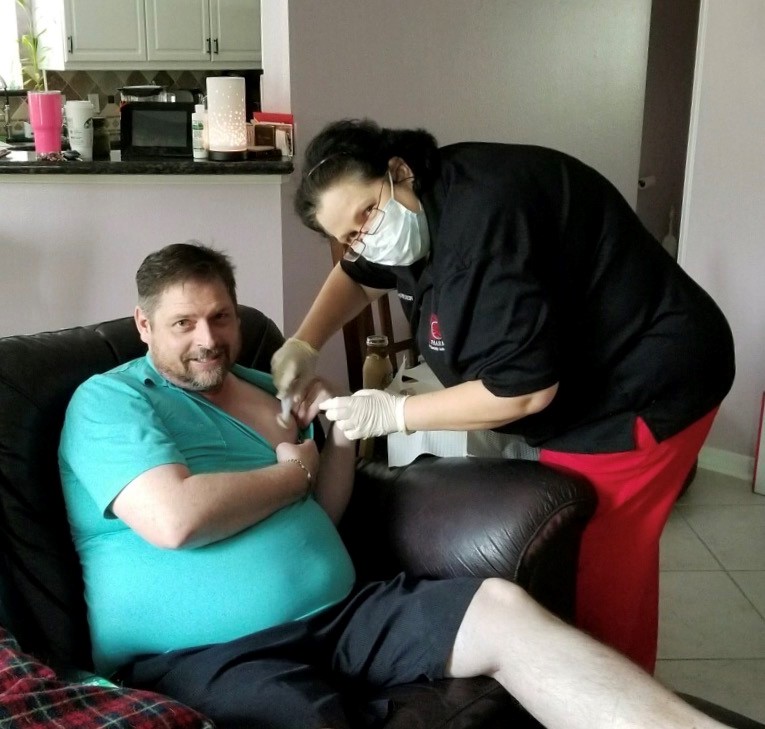As a member of CSI Pharmacy’s patient advocacy team, it’s my job to create materials for our campaign to increase plasma donations. We’re working to encourage people, especially family members and friends of those who rely on immune globulin therapy, to roll up their sleeves and give back by giving their plasma.
The coronavirus crisis has slowed donations of this life-saving serum from which immune globulin (IG) therapies are made. Together with the Immune Globulin National Society (IgNS), CSI Pharmacy is supporting the #ItsMyTurn campaign, encouraging those of us who are not on the front lines of the battle against COVID-19 to consider this opportunity to be a hero in a different way.
While I sat safely socially isolating in my home, organizing webinars, writing patient stories, and creating social media memes, this voice kept nagging at the back of my head: You could donate, it said.
I could, I thought. But the closest plasma donation center is an hour away from where I live in Central Virginia. But it would take me half the day to donate. But I’d have to do it on a regular basis; a one-time shot won’t work.
Still, I just couldn’t sit here urging others to do this important work if I weren’t willing to get off my “buts” and do my part too. I work remotely all the time anyway, and I could bring my laptop and check social media while I donated. I could commit to donating once a week. So I made an appointment and started donating.
But I’m not the only member of the CSI Pharmacy staff getting out of the workplace to donate plasma. Our leadership is making this a movement by encouraging all employees to become plasma donor heroes. And CSI Pharmacy CEO James Sheets is leading the way to the donation center.
“This is an opportunity for us to give back to our community of patients who depend on this life-saving therapy,” James says. “Our patients are our family, and we can’t let them down. We have to do what we can to be sure they can get the treatments they need.”
For my colleagues who work at the pharmacy headquarters in Wake Village, Texas, there is a certified plasma donation center just three miles away in Texarkana. CSI Pharmacy team members are given time to donate during working hours. Those who donate receive a special #ItsMyTurn t-shirt. James has even created a contest to encourage employees to make donating a routine part of their week.
“Our team members are motivated to this cause, because they’re so connected to our patients and their therapies,” James says. “They know how challenging it can be for folks when IG products are in short supply.”
With seven donations under his belt so far, delivery technician Justin McNeill is leading in donations among the CSI Pharmacy employees. He’s grateful for the time to give, but for him it’s not really about the contest or the modest payment he receives as a donor.
“If there’s a shortage on our IG products, our patients aren’t going to get the medicine they need,” Justin says. “I figure I’ve got it to give, so I might as well.”
Roxanne Ward, CSI Pharmacy’s Regional Nursing Supervisor in Little Rock, Arkansas got three of her nurses together to make an event of their trip to the plasma donation center. Knowing that plasma donations are down right now is what made her want to take this extra step for her patients.
“I treat so many people who rely on this,” she says. “I felt like donating is the least I can do to help the people I care for.”
Not everyone at CSI Pharmacy will qualify to donate plasma, though. Eligibility guidelines are strict, so those with certain medical conditions, those who take certain medications, or those who may have been exposed certain blood-borne pathogens won’t be able to give. These team members can still participate in our program, however, by recruiting someone else to donate in their place.
“We’re really proud of the response from our team members,” James says. “It’s an important effort, and we’d like to invite other businesses and organizations to join this effort to short-circuit an IG shortage by encouraging their employees to donate plasma. Together we can make a difference.”
#ItsMyTurn








